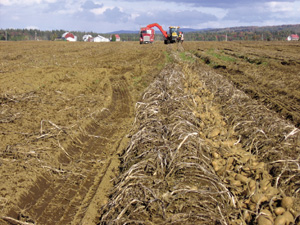
Features
Agronomy
Insect Pests
Making zones work
Producers make buffer zones part of their management.
November 14, 2007 By Donna Fleury
 For potato growers in Prince Edward Island, the buffer zone legislation that
For potato growers in Prince Edward Island, the buffer zone legislation that
came into effect in 2000 has changed the way they manage their farms. The buffer
zone legislation was introduced on crop land to reduce the risk of nutrient,
sediment and pesticide losses to watercourses. The ultimate goal was an improvement
in water quality and a reduction of impacts on fish and other aquatic species.
With almost 100 percent compliance, producers have met the challenge and are
making buffer zones a workable management practice.
"The buffer zone legislation covers a number of scenarios, including crop
production, intensive livestock operations, forestry operations and land development,"
explains Ron DeHaan, acting manager of the Sustainable Agriculture Section,
Prince Edward Island Department of Agriculture, Fisheries and Aquaculture. "For
crop production, including potatoes, the legislation requires that a 10 metre
buffer zone be left adjacent to a watercourse or wetland. If the slope exceeds
five percent in the next 50 metres, they have the option of either leaving a
20 metre buffer or they are not permitted to perform fall tillage in this next
50 metres and they must establish winter cover after the harvest of the potato
crop in this next 50 metre zone."
In addition, if the required buffer zone is forested and the potential exists
for flow to be directed to a headland by the potato rows in the upslope part
of the field, these headlands must be left in grass if they are within 200 metres
of a watercourse or wetland. "Producers traditionally left a headland which
was planted to potatoes at the ends of the field so that they would not have
to pull in their sprayer booms, making for more efficient pesticide application,"
explains DeHaan. Because potatoes are a hilled row crop, planted headlands at
the lower end of fields could intercept runoff from between individual rows
in the upper part of the field and they would concentrate the flow, directing
it to a low point along the length of the headland. This concentrated flow has
the ability to travel for hundreds of metres once it has left the field with
a greater likelihood of it getting into watercourses. Grassed headlands prevent
the flow from concentrating.
"The establishment of buffer zones and grassed headlands has drastically
reduced the number of fish kills, attributed to pesticide runoff on Prince Edward
Island, over the past three years," says DeHaan. "The removal of Azinphos
methyl from the market, a very toxic foliar insecticide, has also had a huge
impact in reducing the number of fish kills." Many producers now use Admire,
an in-furrow insecticide applied at planting time, which gives efficient control
of Colorado potato beetles.
If the 10 metre buffer zones are grassed, producers can use them for turning
farm equipment and they can harvest hay if desired. They are allowed to re-establish
the grass buffer once every five years, but it has to be done in a year when
the balance of the field is not in potatoes or some other row crop. The re-establishment
must be done with spring plowing and either direct seeding, or establishing
grass as an underseeded cereal crop.
"It is recognized that producers have made a sacrifice to comply with
this legislation. They have lost productive land and they require more diligent
management," explains DeHaan. "For example, a lot of producers have
had to do additional training for their equipment operators to make sure they
understand the requirements of the buffer zone legislation. Some producers will
go out to the various fields with their equipment operators prior to fall tillage
and flag everything off so the operator doesn't encroach on the buffer areas."
The legislation has also had an economic impact on producers. "If producers
were farming land within the buffer zone prior to the legislation, then they
will have realized an economic loss of however much land that they had to take
out of production," notes DeHaan. "Good potato land in Prince Edward
Island can range in price from $2000 to $4000 per acre, depending on the year."
Prince Edward Island has the most comprehensive buffer zone regulations in
Canada. Quebec does have buffer zone legislation, but it is not as restrictive
as Prince Edward Island. "On Prince Edward Island, the Department of the
Environment enforces the buffer zone legislation, and over the past three years
they have found almost 100 percent compliance with the legislation," says
DeHaan. "The producers are making the buffer zone requirements work and
are doing a great job. Their efforts have certainly helped achieve the goal
of reduced sediment, nutrient and pesticide loadings getting into Prince Edward
Island's watercourses." -30-